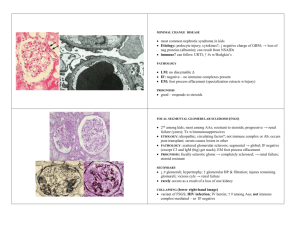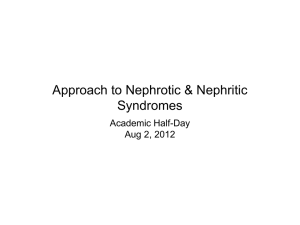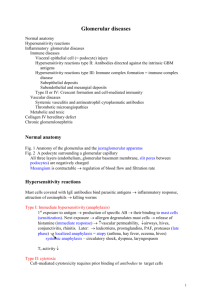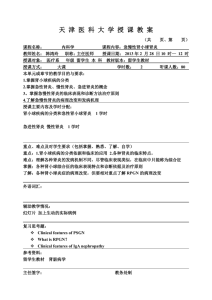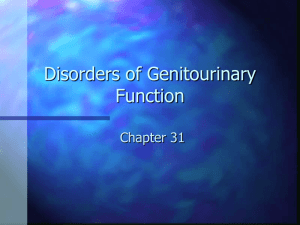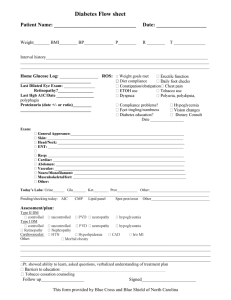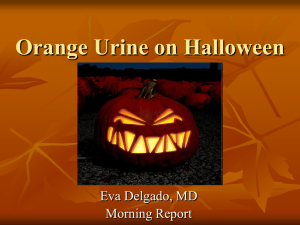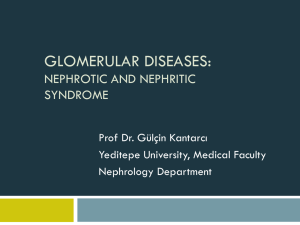Minimal Change Disease
advertisement
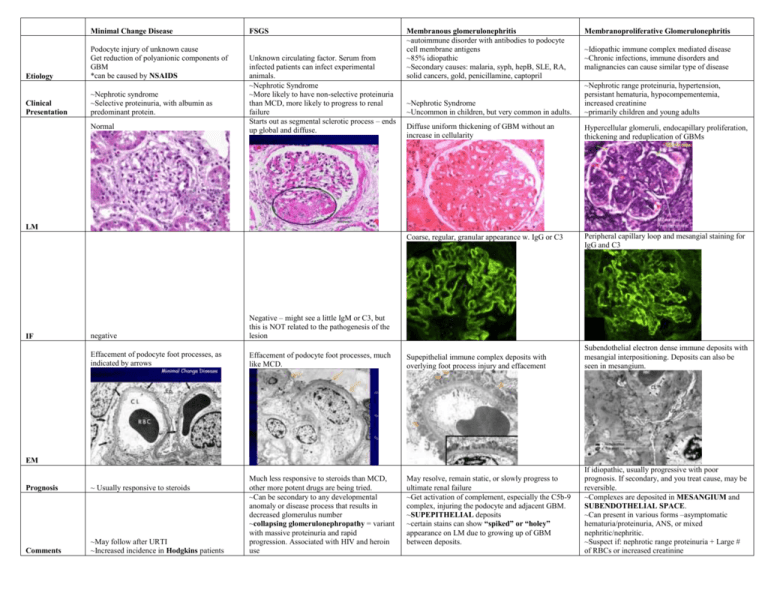
Minimal Change Disease Etiology Podocyte injury of unknown cause Get reduction of polyanionic components of GBM *can be caused by NSAIDS Clinical Presentation ~Nephrotic syndrome ~Selective proteinuria, with albumin as predominant protein. Normal FSGS Unknown circulating factor. Serum from infected patients can infect experimental animals. ~Nephrotic Syndrome ~More likely to have non-selective proteinuria than MCD, more likely to progress to renal failure Starts out as segmental sclerotic process – ends up global and diffuse. Membranous glomerulonephritis ~autoimmune disorder with antibodies to podocyte cell membrane antigens ~85% idiopathic ~Secondary causes: malaria, syph, hepB, SLE, RA, solid cancers, gold, penicillamine, captopril Membranoproliferative Glomerulonephritis ~Idiopathic immune complex mediated disease ~Chronic infections, immune disorders and malignancies can cause similar type of disease ~Nephrotic Syndrome ~Uncommon in children, but very common in adults. ~Nephrotic range proteinuria, hypertension, persistant hematuria, hypocompementemia, increased creatinine ~primarily children and young adults Diffuse uniform thickening of GBM without an increase in cellularity Hypercellular glomeruli, endocapillary proliferation, thickening and reduplication of GBMs Coarse, regular, granular appearance w. IgG or C3 Peripheral capillary loop and mesangial staining for IgG and C3 LM IF negative Negative – might see a little IgM or C3, but this is NOT related to the pathogenesis of the lesion Effacement of podocyte foot processes, as indicated by arrows Effacement of podocyte foot processes, much like MCD. Supepithelial immune complex deposits with overlying foot process injury and effacement Much less responsive to steroids than MCD, other more potent drugs are being tried. ~Can be secondary to any developmental anomaly or disease process that results in decreased glomerulus number ~collapsing glomerulonephropathy = variant with massive proteinuria and rapid progression. Associated with HIV and heroin use May resolve, remain static, or slowly progress to ultimate renal failure ~Get activation of complement, especially the C5b-9 complex, injuring the podocyte and adjacent GBM. ~SUPEPITHELIAL deposits ~certain stains can show “spiked” or “holey” appearance on LM due to growing up of GBM between deposits. Subendothelial electron dense immune deposits with mesangial interpositioning. Deposits can also be seen in mesangium. EM Prognosis ~ Usually responsive to steroids Comments ~May follow after URTI ~Increased incidence in Hodgkins patients If idiopathic, usually progressive with poor prognosis. If secondary, and you treat cause, may be reversible. ~Complexes are deposited in MESANGIUM and SUBENDOTHELIAL SPACE. ~Can present in various forms –asymptomatic hematuria/proteinuria, ANS, or mixed nephritic/nephritic. ~Suspect if: nephrotic range proteinuria + Large # of RBCs or increased creatinine Etiology Acute Nephritic Syndrome ~Immune complex mediated: complexes form and activate complement subendothelially and then migrate to epithelial side ~Most commonly, post-streptococcal glomerulonephritis ~Others – SLE, severe IgA nephropathy, membranoproliferative Lupus Nephritis ~Hematuria, proteinuria (usually not nephritic range), hypertension, mild renal insufficiency Can present in multiple diff ways: nephrotic syndrome, ANS, asymptomatic hematuria/proteinuria, or ARF Clinical Presentation Immune complex mediated, complexes can deposit in any part of the kidney. Two major glomerular changes: proliferative and membranous Diffuse endocapillary proliferation IgA nephropathy Unknown cause, but results from trapping of IgA subtype 1 containing immune complexes in the mesangium ~asymptomatic hematuria/proteinuria ~Most commonly in children and young adults ~Often history of URTI Mesangial hypercellularity but nice open capillary loops Alports Disease ~Hereditary defect in Type IV collagen production ~X linked: absent α5 isoform ~autosomal: absent α3 or α4. Hematuria, high frequency hearing loss, various ocular defects Nonspecific – glomeruli may look normal or like they are scarring LM “lumpy bumpy” or “starry night”. IgG and C3 Deposits in mesangium and loops. “full house” effect IgA and C3. Can have trace IgG and IgM ~routinely negative ~can use anti-sera against various isoform chains of Type IV collagen and demonstrate lack of chains in the GBMs of affected patients. IF Large, randomly spaced,subepithelial humps “fingerprint-like” substructure with tubuloreticular inclusions Mesangial densities, matrix increase Thick GBMs, basket weave pattern ~better predicted by the chronic changes present at the time of biopsy than the amt. of active lesions ~good if few chronic changes May be benign, but progresses to CRF in 10-15%. No effective treatment, trials for fish oil. ~Progress to ESD at various rates. Renal transplant is the only real treatment when failure ensues ~Problem with transplant: anti-GBM disease ~Treat with steroids and cytotoxic agents like cytoxan with good results as long as there are few chronic changes present. ~Most common cause of primary glomerulonephritis in the world. ~No C4 or C1q, therefore alternative pathway Very uncommon, responsible for about 2-3%of ESRD in young people. EM Prognosis Comments ~Kids: 95% recover spontaneously, ≤1% get RPGN, 1-2% progress to CRF ~Adults: 60% recover spontaneously, 40% develop RPGN or CRF ~Typical post-strep presentation: abrubt onset 13 weeks after throat infection or 3-6 weeks after skin infection with group A beta hemolytic strep. Symptoms: edema, hypertension, hematuria, azotemia, mild proteinuria and oliguria. Early in disease, low C3 and C4. Positive ASO or anti-DNAseB. ~Can see C1q and C4 on IF = classical cascade Thin Basement membrane disease Etiology Clinical Presentation ~Autosomally inherited defect in GBM, but the etiology is unclear. ~Some evidence of abnormalities in genes coding for the α3 and α4 isoforms of Type IV collagen. Asymptomatic hematuria or proteinuria, often only picked up by routine physical. Type 1 RPGN Type 2 RPGN ~Anti-GBM disease ~Caused by: idiopathic, exposure to hydrocarbon solvents, influenza A2 virus, malaria, Hodgkins disease ~Immune complex mediated ~Caused by things like: SLE, post-strep GN, membranoproliferative GN, IgA nephropathy Present with renal problems as well as symptoms of underlying disease Type 3 RPGN ~Pauci-immune disease ~No immune complexes or anti-GBM antibodies found by IF or EM ~90% positive for ANCA ~Often found as component of systemic vasculitis (like MP or Wegeners) Glomerular crescent LM Normal Bright linear IgG fluorescence IF Negative Abnormally thin basement membrane EM Prognosis Comments Crescent shape seen with anti-fibrin IM…characteristic of all crescentic GNs. Progression to ESRD is uncommon but can occur No immune deposits seen. Severe glomerular damage. Good if diagnosed early – plasmapharesis and cytotoxic drugs can restore function ~Associated with HLA haplotype DR2 ~Uncommon in blacks ~May be associated with pulmonary BM attack = Goodpastures Crescents are caused by proliferation of cells in Bowmans space with collapse of glomerulus. Get leakage of plasma proteins.
